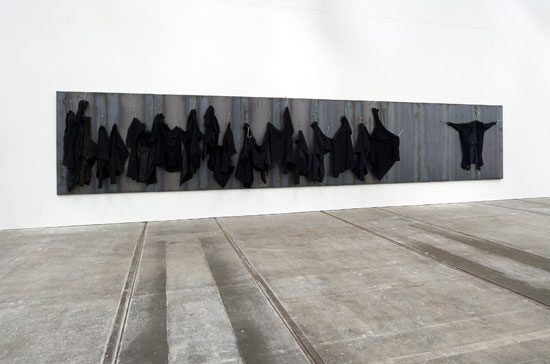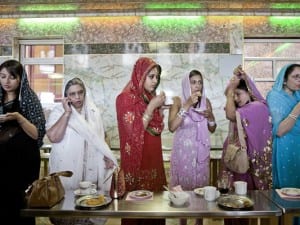18 black wool coats hang from meat hooks mounted on iron panels. Dozens of multi-patterned, colourful rugs lie on the concrete floor. Five brown canvas sacks suspended by hemp ropes and filled with wooden furniture hover over our heads. Underneath, black wool coats lie in rows, numb on the floor, clothing 31 2 metre long l-beams. A heap of coal leans against iron panels. Seven church bells lie on iron panels on the ground and three bells suspended with ropes from three wooden beams within a steel l-beam frame echo the lull of impending death. Seven burlap sacks containing coffee beans, lentils, rice, dried peas, corn and red and white beans seem to be the only work that underlines a sense of hope. The brick walls of Tramway’s ground floor gallery on Glasgow’s Albert Drive surround these works of prodigious importance. In other words, they surround the works of Jannis Kounellis.
The 18 black wool coats hanging from large meat hooks appear to be shaped into the human form. There is a broken man on the far left, next to him two little girls swaddled in black burkas holding hands while next to their torn childhood joys, women draped in black burkas stand. The figures become misshapen as the installation extends to the right; their bodies become unintelligible. An image perhaps connoting the dissolution of human identity gradually appears before our eyes. The coldness of the iron panels behind the suggested bodies emphasise the challenge posed by the tension between the human body and the object. The site-specific work by Kounellis denotes death and silence just as much as it does the disintegration of society.
The entire length of the right side of the gallery accommodates Kounellis’ work Untitled (2004). Over a hundred steel girders have been welded together and transformed into Cruciform shapes, weighing heavily upon the individual Oriental rugs. The installation is representative of a massive unfinished tent or yurt. It allows the visitor to sense the emptiness caused by the overbearing lack of human feeling. A black hat and coat hangs from one of the beams at the top right corner, whispering the sentiment, “Home is where you hang your hat.” Yet, this is a home short of providing shelter of any kind, physical or emotional. Kounellis describes the work as “a clash of civilisations, a meeting of technology and spirituality”. However, there seems to be more to this piece… It painstakingly describes the collision between Christianity and Islam and the dispute between the rich forever becoming richer and the poor staying poor evermore. It is a visual soliloquy on the living and the dead, as are the silent church bells hanging in the steel l-beam frame, (Untitled, 1993). This understanding is replicated by the church bells resting on large iron panels on the floor (Untitled, 2006).
Five brown canvas sacks containing furniture and hovering above the centre of the gallery seem to impose their heft on the dead bodies of men, women, children. It reminds one of all the genocides and all the poverty he reads of; the humiliation people experience around the world, as countless individuals and societies have previously suffered throughout history.
Another truly powerful work is the blocked doorway in the gallery. Kounellis employs the dry-stone walling technique, commonly used to mark boundaries or to divide farmland. The brown bricks protrude from the white ones that form the rest of the wall to signify the segmented, divided and abandoned minority cultures of the world.
The exhibition denotes the “dark hours” of Kounellis’ work but also offers hope through his installation Untitled, (1969). Seven burlap sacks, one for each day of the week, are filled with bounties of Mediterranean lands. It takes us away from the high-tide of technology and delivers us to the old world where the sights and scents of almost extinct grocers, the hustle and bustle of market towns and the colourful lifestyles to be had in seaports such as Piraeus, Kounellis’ birth place. The work is an epitome of Arte Povera as it unites art with day to day living, suffering and loss.
Time stops, silence suspends in the air, make-shift corpses rest on the bone-dry concrete floor. The untitled exhibition composed of untitled works hits the conscience of any art-lover like a brick to the face, leaving those who are artistically inquisitive temporarily stunned.
Artist Rooms: Jannis Kounellis, 21st July until 23rd September, Tramway, 25 Albert Drive Glasgow, G41 2PE. www.tramway.org
Text:
Hande Eagle
Credit:
Photograph: Keith Hunter





